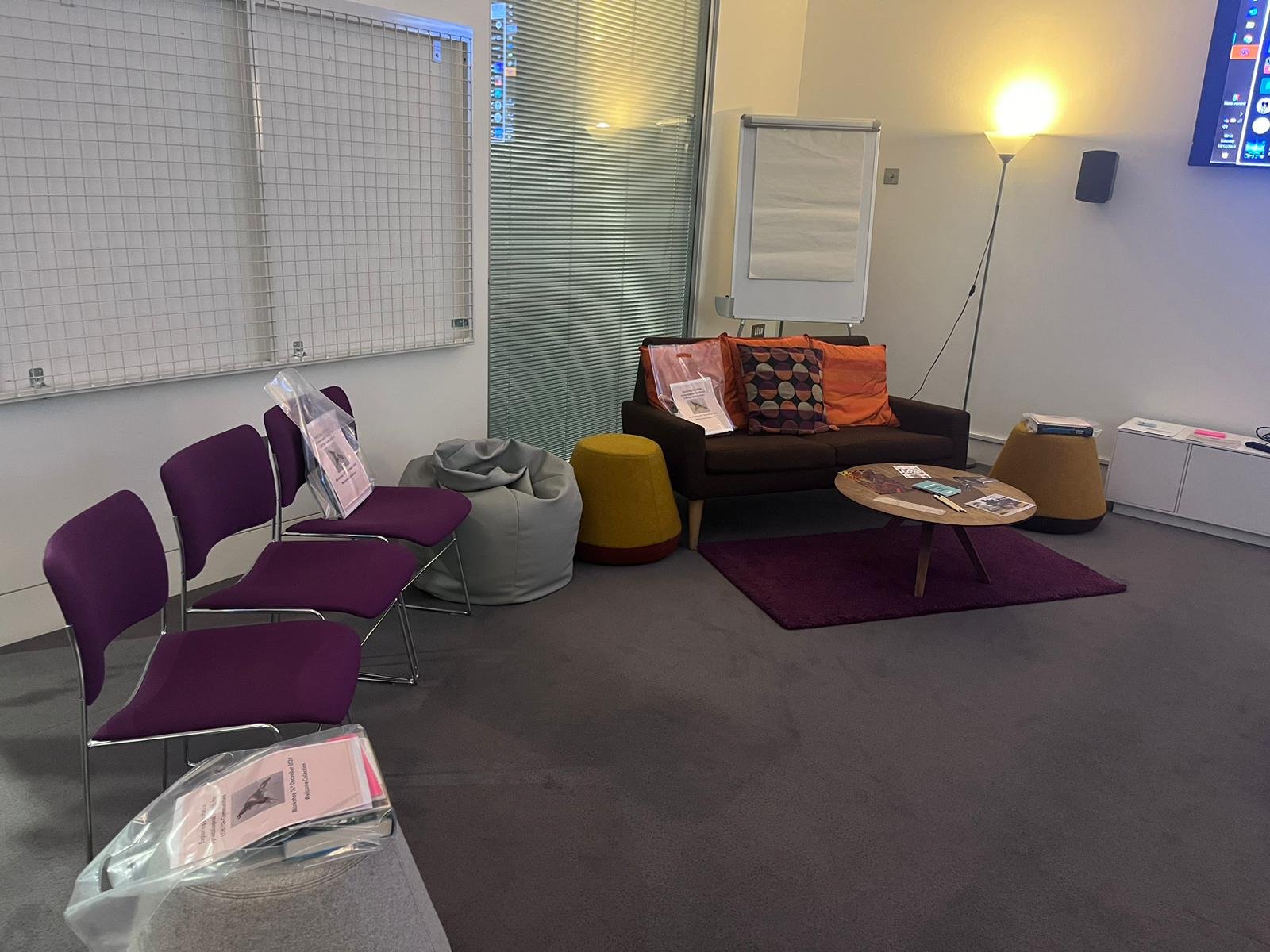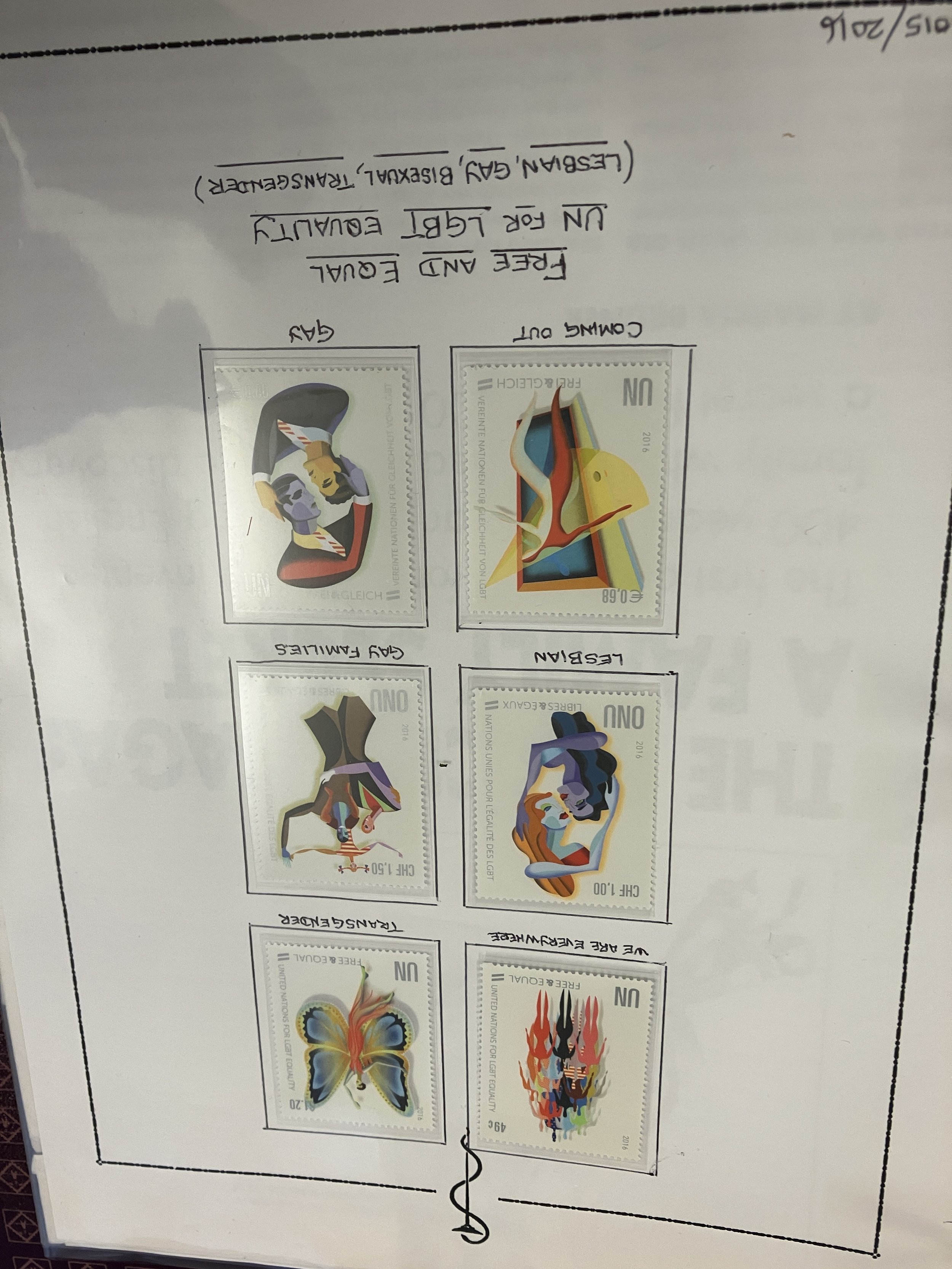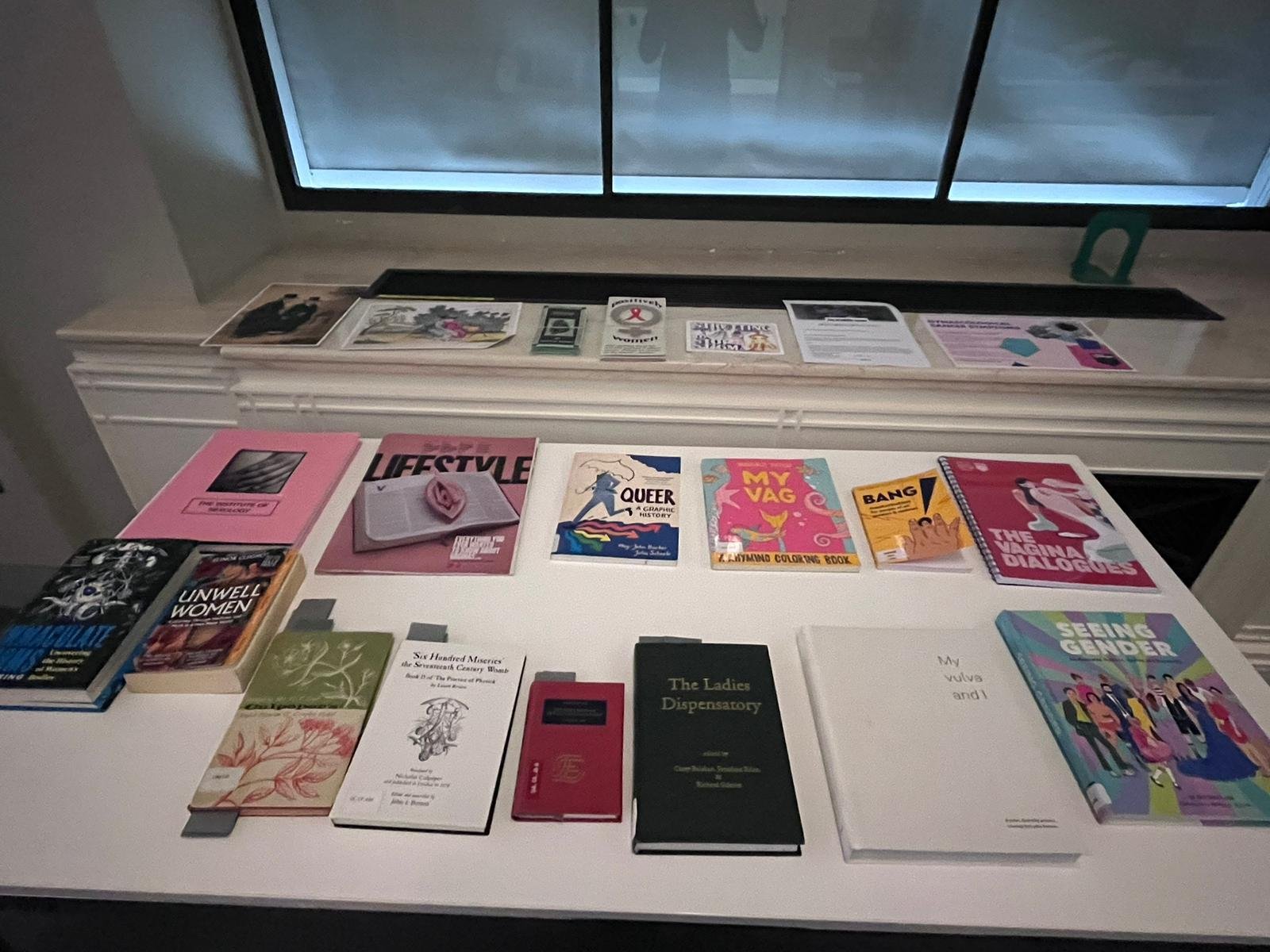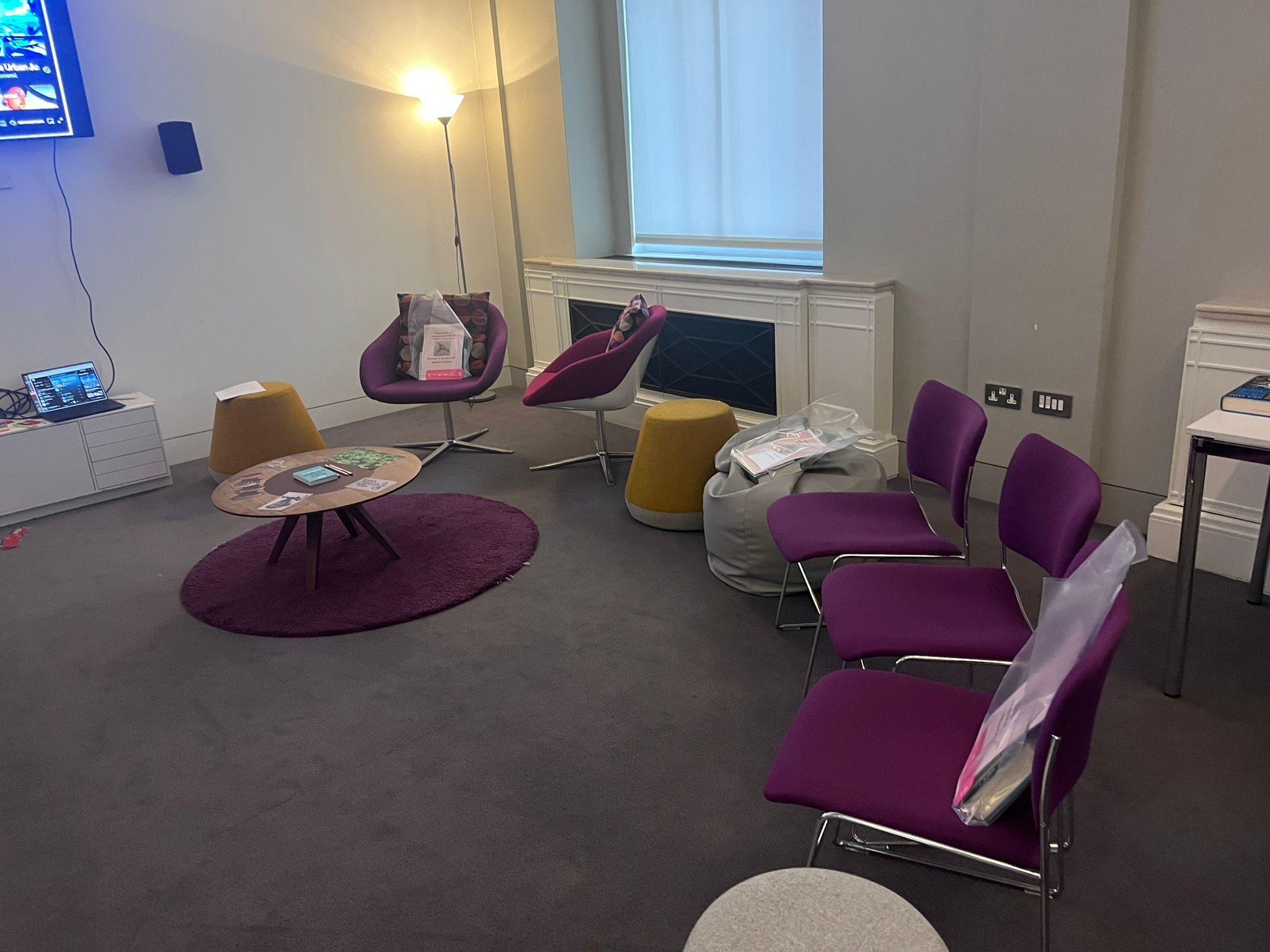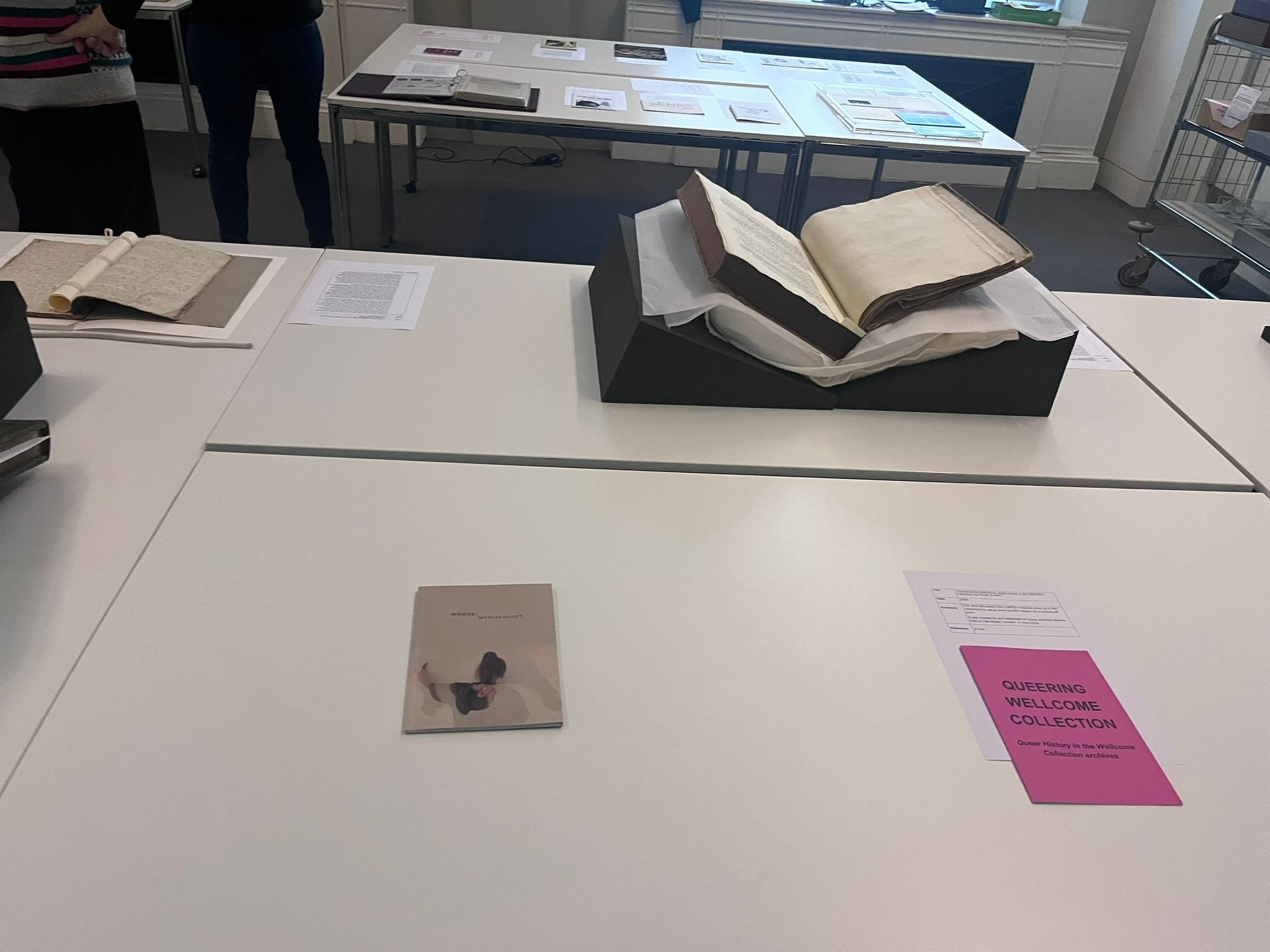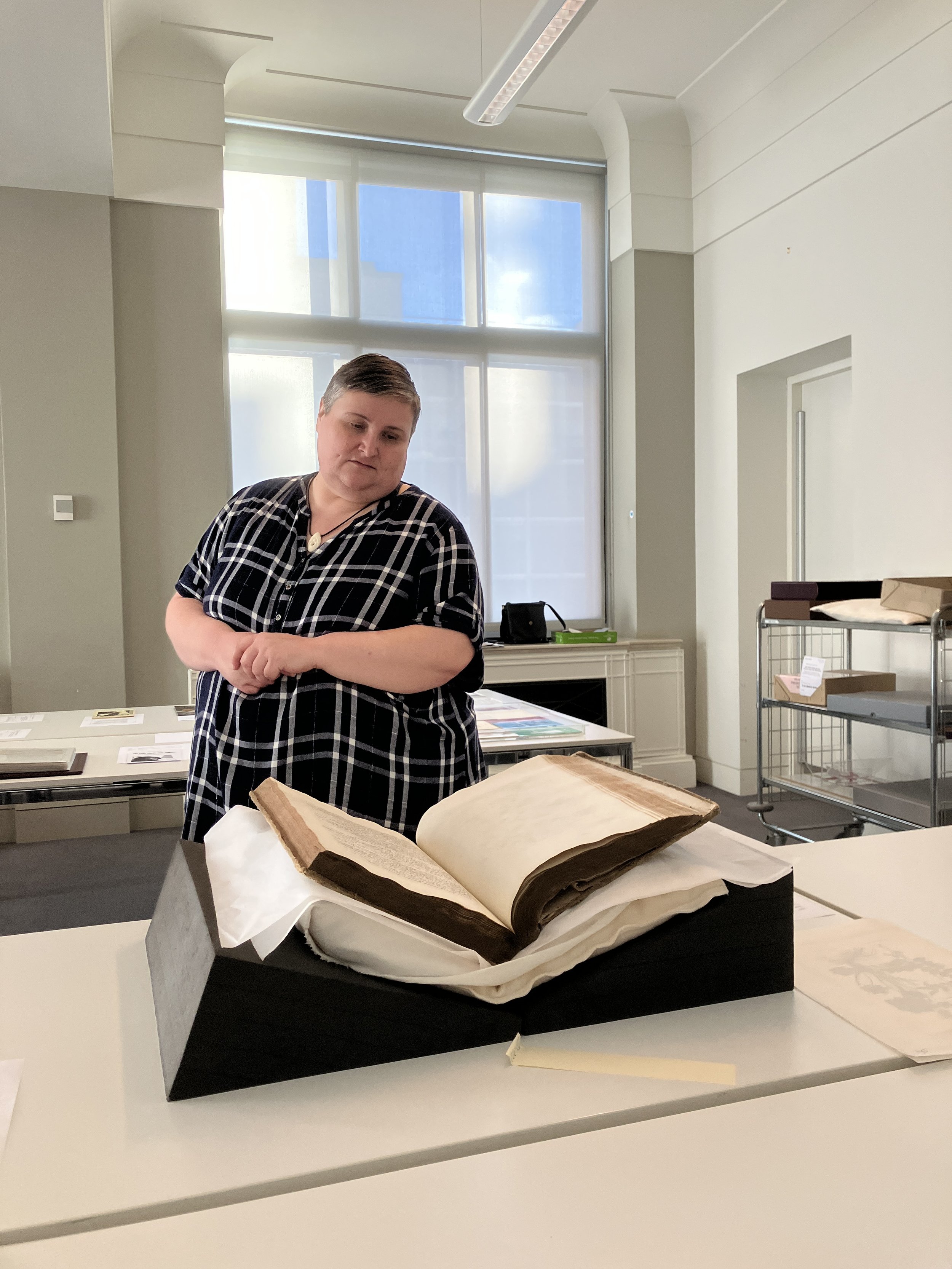
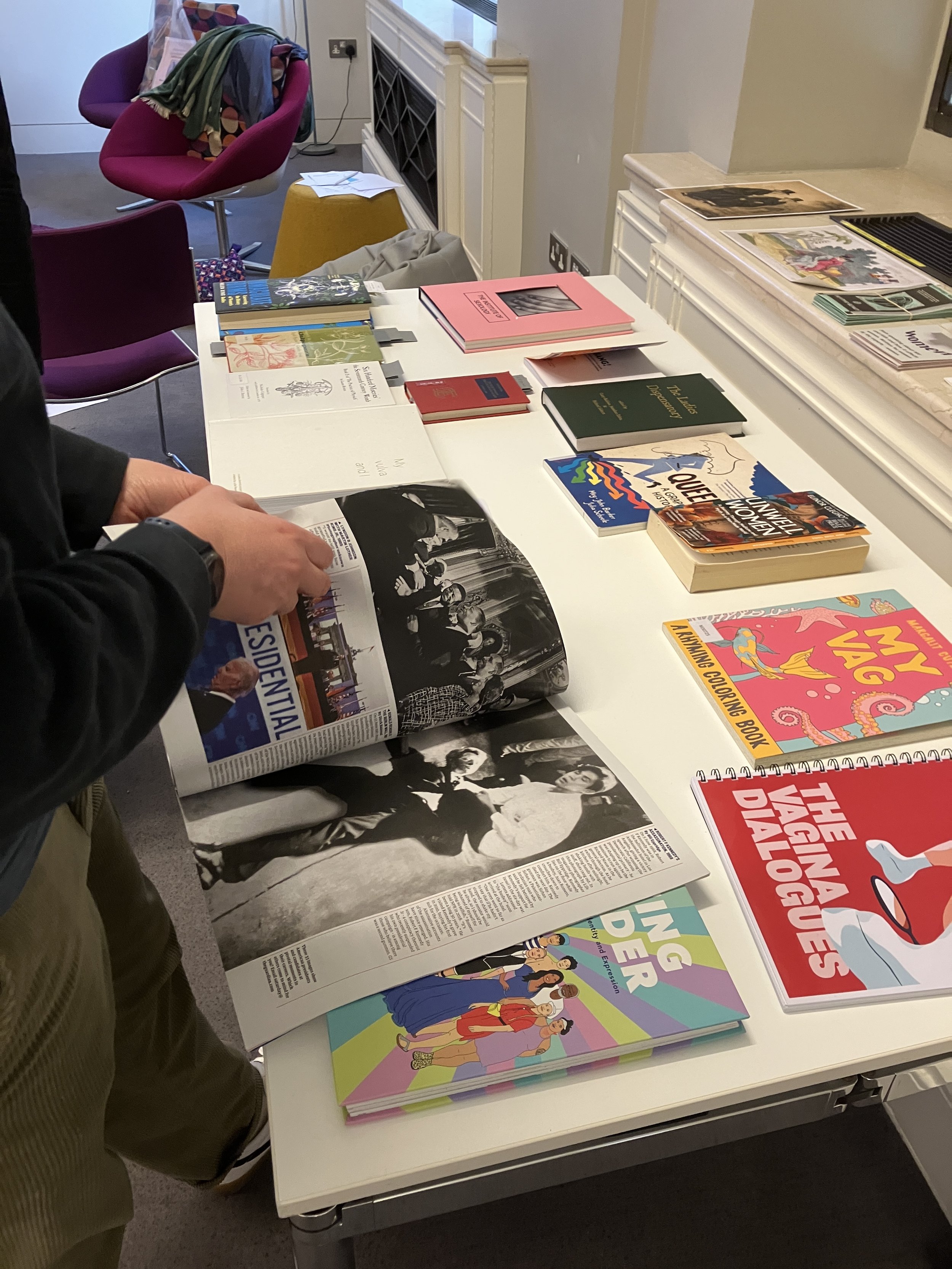

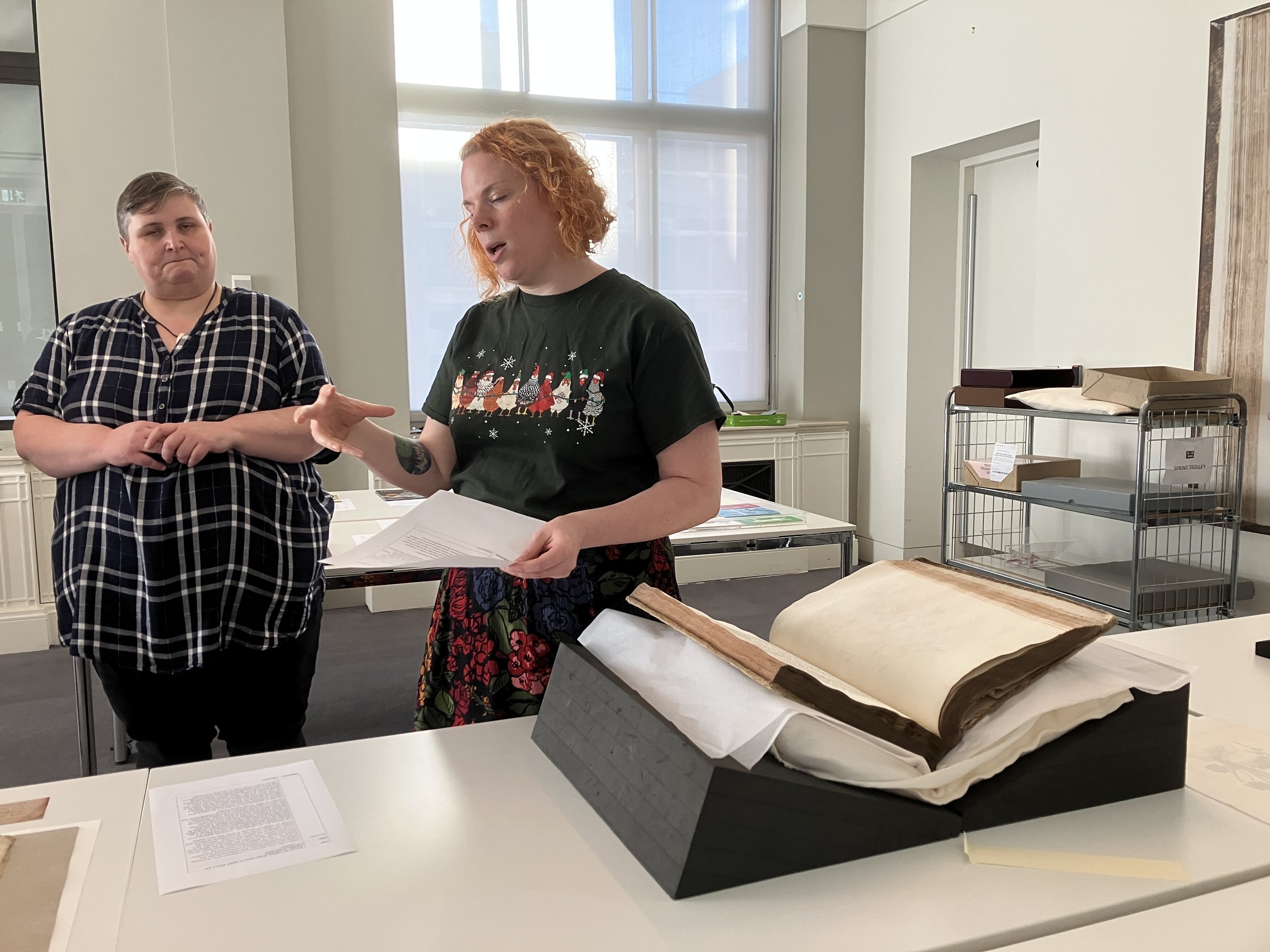
field notes: in-person session at the wellcome collection
Our in-person session was held at the Wellcome Collection on Saturday 14 December.
We had two aims:
1) To give the group members an opportunity to get to know each other (and the Wellcome team), face-to-face
2) To begin a gentle familiarisation with some of the collection materials we’d found through our research (i.e. highlight items that represent the wider scope of themes that were raised in the online session as potentially of interest.)
We took time and care in planning the session. This included:
Sending a feedback form around the group to assess how individual needs could be met e.g. comfort, mental and physical health, dietary requirements, travel support.
Ensuring the room had a mix of furniture – from hard chairs to stools and sofas, with plenty of space to move around.
Providing a private space for our trans, stealth group member and holding separate conversations with them in advance to make sure their entrance and exit was anonymised along with participation on the day.
Giving support for travel, including covering costs for hotel and train travel (plus any chaperones) providing directions, and offering pastoral support on the day for anyone who needed it.
Being clear that group members could withdraw at any point if feelings of anxiety or worry became too much (i.e. giving permission and agency so that group members did not feel obliged to attend if they weren’t up to it).
Providing lunch vouchers for the café (and giving choice for either take away or sit-in options) and booking a dedicated space in the building for anyone wanting to remain inside.
Presenting a wayfinding introduction to the building before we started the main content of the day, so that the group got to know the working environment, including gender neutral loos, lockers, water coolers and break out spaces etc.
Sending visualisation documents in advance which showed the interior and exterior of the Wellcome with introductions to the space so that they were able to familiarise themselves in advance if they wanted.
Building in scheduling time at the end of the session to ‘check in’ with everyone on how they were feeling and to support/address any concerns so that it was a ‘good’ ending.
Sharing support organisation numbers/websites in a pack which group members went home with in case they needed after care.
With limited time together (and conservation restrictions on how much material we were allowed in the room), the main session was split into four different parts:
1) Ice-breaker activity: we printed out ‘teaser’ images of carefully researched collection items, cut these to shape and presented them on small tables in the ‘break out’ area. Group members were asked to choose something in front of them that they found intriguing. The Wellcome team then did a quick-fire introduction to the group member’s selected image, and this led to some immediate responses and discussion. We purposefully chose items that might allow for a good ‘entry point’ for the group; material that told stories which were potentially interesting, shocking, or humourous, with a view to getting the conversation flowing.
2) Topics in focus: following many hours of research behind the scenes by myself and the Wellcome team (and taking the lead from group members in the previous online session on topic interests), we selected a small number of items to present to the group in greater detail (these are listed below). The Wellcome team provided some context, and we took immediate verbal reactions from the group. They were also given feedback cards and pencils to write their responses on anonymously. We then broke into two smaller groups to discuss key questions. These included:
How did these materials make you feel?
Which items/stories resonate the most and why? Especially through an unequal and inequitable LGBTQ+ lens?
What questions or thoughts do these materials raise in terms of gender and sexuality?
How would we want to reinterpret these objects through a queer lens? What stories would we tell based on our lived experience? (If these items were displayed here in an exhibition and we were in charge of writing the labels, what would we say?)
What other questions did the material raise for you?
What might you like to explore further?
We had a 45 minute break for lunch and then looked at a second set of materials and repeated the discussion activity.
3) De-brief: we closed the session with a facilitated discussion to reflect on the day, gather final thoughts and to start a conversation about potential ways to take this participatory research forward. It was also an opportunity to check-in and make sure everyone was OK before they headed home. Everyone took a ‘goody’ bag with them, including Helen King’s book ‘Immaculate Forms’.
Group feedback to the collection
The group member’s immediate response to the material was powerful. It confirmed that this work is meaningful and necessary. It also reconfirmed to me (not that I needed persuading!) that important conversations (and potential direct action) can be inspired by museum collections. Collectively we shared first hand lived experiences of our gynae journeys. Our conversations highlighted the need for activism and campaigning, lack of representation, and identified gaps in the collection materials. It showed how little things have changed. Some of the more specific areas of discussion included:
The fact that there’s little health advice for trans people and the impact of testosterone is also a lack of knowledge. A view that essentially trans people are ‘wiped from the system’.
Historical objects around gynae health appear to neglect the humanity behind the women, or their stories.
When you are trans navigating the healthcare system, everything ‘becomes so much more’; you receive intrusive questions about what medication you use and inappropriate lines of questioning.
Sex is always seen as something you do with a man – not allowed pleasure, not seen as sexual beings.
Gynae health is tied into usefulness or uselessness – women are just seen as baby producers rather than e.g. sexual beings.
Misunderstanding around smears – there’s the perception that lesbians don’t need one because they are not with a man; more understanding and context is needed.
There’s a division between reproductive organs and gynae health – how else are people talking about healing?
Importance of the human factor – there’s a human body around this material, where are the people in these stories?
The clitoris is forgotten and ignored
Gynae organs have Latin names – which contributes to how misunderstood they are
Ovarian cancer is still classed as an old woman’s disease – we haven’t moved on/progressed
Sexual pleasure for women is not present in the historical material
There’s broader misinformation when it comes to gynae health regardless of gender and sexuality
Hysteria is still ascribed to women today
The fact there’s needs to be more training for frontline staff and for non-medical staff in the NHS to share our lived experience – this project should be used to influence
Lots of negative experiences of women in both the historical and contemporary materials on display – there’s a need for change: there’s not much difference between then and now. How can we overcome the censorship? How can we talk more about shame?
Constantly having to out yourself in medical settings is burdensome and painful
People don’t know about HPV and where it comes from – there’s misinformation about gynae cancers
Invisibility, misinformation, miscommunication, euphemisms and assumptions (e.g gay women don’t want children) – these are themes in both the older material and in contemporary material and experiences
Experiencing cancer as a queer person is a distinct experience – yet people claim that all experiences of cancer are the same
Interested less in Sims (see material items below), but more so about the enslaved women he tested on, where are their stories?
Periods are always seen as ‘dirty’, terms like ‘sanitary’ and ‘hygiene’ are always used, we always have to ‘pretty it up’ - scented pads can be seen as linked to fumigators (see material items below).
Queer zines which provide health information should be made more accessible and integrated into mainstream health information. Zines can be physically passed around – so it’s a way to combat censorship and means it won’t be harvested by AI. The zines need to get into the hands of more people especially health professionals.
Language around checking yourself e.g. vulva checking still uses euphemisms e.g. ‘lady garden’. Why can’t we just use the proper names?
Recipe books written by women allowed for women to share and build community – there are parallels today e.g. you learn more about cancer from other women than from oncologist
Invisibility of working-class women – how do they get their medical knowledge?
Lots of binary splits – what about intersex people?
Important to consider intersectionality.
Useful considerations/learning points
It was vital to give time and care when planning the session. Taking a trauma-informed, care-focused approach meant that we put a lot of thought into the logistics.
Participatory research within this socially engaged context needs time allocating/budgeting to do it properly. I’ve benefited from having the Wellcome team in the background spending hours on collection research – this has fast-tracked my own research and creative response. As I’ve covered in previous field notes from this project, we are also paying group members a £200 fee for their input and time on this first phase of the project. We continue to feel this is the right thing to do when people are spending time with us, sharing their ideas and knowledge and potentially taking time off work and home responsibilities.
In an ideal world we would have spent longer on debate and discussion. Having spent months researching the collection, the Wellcome team and I are familiar with the materials. But this was not the case for the group members, and so I question whether they could have potentially benefited from reducing the number of items so that everyone could spend longer reading/digesting them. Conversely however, the point of the session was to just give an entry point, a flavour of what’s available – i.e. breadth rather than depth – with a view to exploring in greater detail in the next phase. I’m still not sure which would have been the better approach.
Working with a group including vulnerable members and continuing my commitment to safeguarding has led me to considering the inclusion of adding emergency contact details to my consent form. This is something that would be covered by my ICO/GDPR systems but is not information I currently collect from group members on any of my socially engaged projects. Giving greater encouragement to group members to bring a chaperone (and paying for those) would also be something I would build into any future trips and budgets.
The day was energising for me and the Wellcome staff team, however it was also surprisingly emotionally draining. This was unexpected and something to bear in mind that everyone – not just the group members – need taking care of. As with all trauma-informed research, the researchers themselves need looking after when hearing potentially emotive or triggering stories from those ‘being researched’.
What’s next?
We’re currently spending time and taking care in designing the next phase of activity, which will see creativity sitting alongside participatory research. Watch this space…
Material on the day
Queering Wellcome Collection : queer history in the Wellcome Collection archives by Rowan Frewin, 2023, a zine that was created for and distributed at Queer and Now festival, held at Tate Britain, London, on 10 June 2023.
Language stigma/Rebellious distempers: Culpeper's Drectory for Midwives: A Guide for Women.
Plate 100: Stinking Arrach (for use in gynae area as a decoction): A curious herbal, containing five hundred cuts of the most useful plants, which are now used in the practice of physick ... To which is added a short description of ye plants; and their common uses in physick by Elizabeth Blackwell, 1751.
Recipe book MS.9317, 17th century: {pag 3} for falling of the vulva or palat.
Gwen Prout Stamp Collection, section on James Marion Sims: Gwen Prout stamp collection vol.107 Obstetrics and Gynaecology #1 | Wellcome Collection
Metamorphosibus Insectorum Surinamensium by Maria Sibylla Merian - 1726.
Depo-Provera a report by the Campaign Against Depo-Provera (1980-1983)
g.endo: a zine 2018. A zine about navigating life with endometriosis and chronic pain alongside being trans. Written by Ro Karas, it is part-comic, part-reflection on their experiences accessing healthcare and coming to terms with their condition.
Joining the dots : a queer fat positive perzine about PCOS 2012 - this zine covers a lesbian woman’s experience navigating the healthcare system with PCOS, and the fatphobia she experienced.
Transpire: transgender cancer patient anthology 2019– this zine is a compilation of art and writing by trans cancer patients, including those with ovarian cancer, testicular cancer, and uterine cancer (2019). There is discussion in this zine from a non-binary person with ovarian cancer of how water colours and art has been a healing and restorative practice for them.
Dykenosis : the newsletter of LesBeWell 1994-1998: a Birmingham based British women's health activist group comprised of queer women, which sought to fill gaps in government health education provisions.
People who menstruate : a comic by Rowan Frewin 2020 - a comic about the importance of inclusive language in health care settings.
A potted trans history by Rowan Frewin 2021 - version of a presentation on trans history that Frewin gave as part of a project with Comics Youth.
Do not harm her sutra : sex positions for creaky older lesbians by Dolly Sen 2020.
Whose menopause?.by Marge Bradshaw 2023 - a zine version of 'Whose Menopause?', an Arts Council England funded project in partnership with Bolton at Home and supported by NHS Bolton CCG and Indigo Gender Service.
Reading table
A Kick in the Belly by Stella Dadzie 2020.
The sick womans private looking-glasse by John Sadler 1636 (reprint 1977).
Institute of Sexology, Wellcome Collection exhibition catalogue 2014.
Unwell women : a journey through medicine and myth in a man-made world by Elinor Cleghorn 2024.
Immaculate Forms by Helen King 2024.
My Vulva and I: a vulva diversity project 2021.
My vag : a rhyming coloring book by Margalit Cutler 2024.
Posters and postcards produced for the 2024 World AIDS Day Red Run.
Teaser images
Votive uterus | Science Museum Group Collection
Vaginal Speculum for Applying Leeches | Science Museum Group Collection
HPV in cervical epithelium | Wellcome Collection
Alchemilla vulgaris (Lady's mantle) | Wellcome Collection
Drawing of vaginal smears | Wellcome Collection
MS.9317 | Wellcome Collection: {pag 3} for falling of the vulva or palat
Portrait, possibly of Lili Elbe. | Wellcome Collection
This participatory research and socially engaged project is being delivered in collaboration with the Wellcome Collection.


